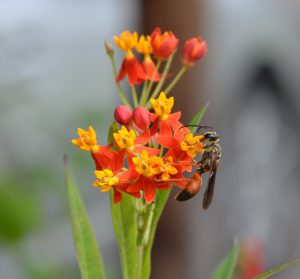
By Les Harrison
Wakulla County Extension Director
Monarch butterflies, Danaus plexippus, are likely the best known butterflies on the planet because of their remarkable and much publicized ability to migrate thousands of miles across international borders and then congregate in the same spots year after year. Their bright colors and animated appearance make them the proto-typical image for this popular insect order.
All that flying takes good health and quite a lot of energy. While adult Monarchs can utilize a variety of nectars, the larvae’s diet is limited to only eating milkweed.
Therein lays the weakest link in this biological chain which stretches into the ancient past. One theory goes the last Pleistocene glaciations in North America instigated migration to Mexico in the east and to the Californian coast and deserts in the west when there was still plenty of milkweed to support their caterpillars.
Milkweed species are currently blooming and producing seed in Wakulla County. Each plant has the potential to nourish one more of these benign and colorful insects.
Monarchs lay their eggs individually on the underside of leaves and sometimes on the flowers of different milkweeds species. There are several native and exotic milkweeds which grow wild in Wakulla County.
These one-at-a-time deposits have several benefits for the larva when hatched. The most notable is these voracious insects have plenty to eat with little chance of competition from other species for the increasing scares dietary resource.
While milkweeds have an attractive bloom, it quickly goes to seed. As such the plant is relegated to wildflower status, sometimes being destroyed as a pest, and rarely cultivated until recent years.
Additionally, the wide distribution of the eggs improves the chances at least some of the eggs will hatch and reach maturity. Monarchs are exclusively vegetarian and not an apex predator.
Invertebrate pillagers such as ants, spiders, and wasps attack monarch larvae on milkweed plants. Tachinid flies and braconid wasps are known to parasitize larvae.
To add to the odds against survival of the eggs and larva, there are several microscopic organisms which can infect monarchs during their formative stages. These included a virus, multiple bacteria, and protozoan parasites.
At the hatching of the first instar, or larval phase, the tiny caterpillar is white with a black head. There is a touch of irony when such a colorful butterfly begins life in this monochromatic form.
Development from the white egg to the adult’s brilliant spender takes less than a month. In North America, the monarchs go through at least four generations a year before they start the migratory trek south in the autumn.
Adult Monarchs are strong fliers which can stay aloft for 11 consecutive hours. In the fall, mature Monarchs have enough fat stored up from plant nectar to permit a continuous flight of over 600 miles without feeding.
There has been a concerted effort to cultivate milkweed and nectar producing wildflower in the area by Wakulla County Master Gardeners and others who hope to see Monarchs continue their transcontinental flight.

Each seed which germinates in local sandy soils offers the possibility of continuing an ageless event which defines nature at its grandest. This seems like a good trade for allowing a weedy wildflower to flourish.
To learn more about milkweed in Wakulla County, contact your UF/IFAS Wakulla Extension Office at 850-926-3931 or https://blogs.ifas.ufl.edu/wakullaco/
 0
0
